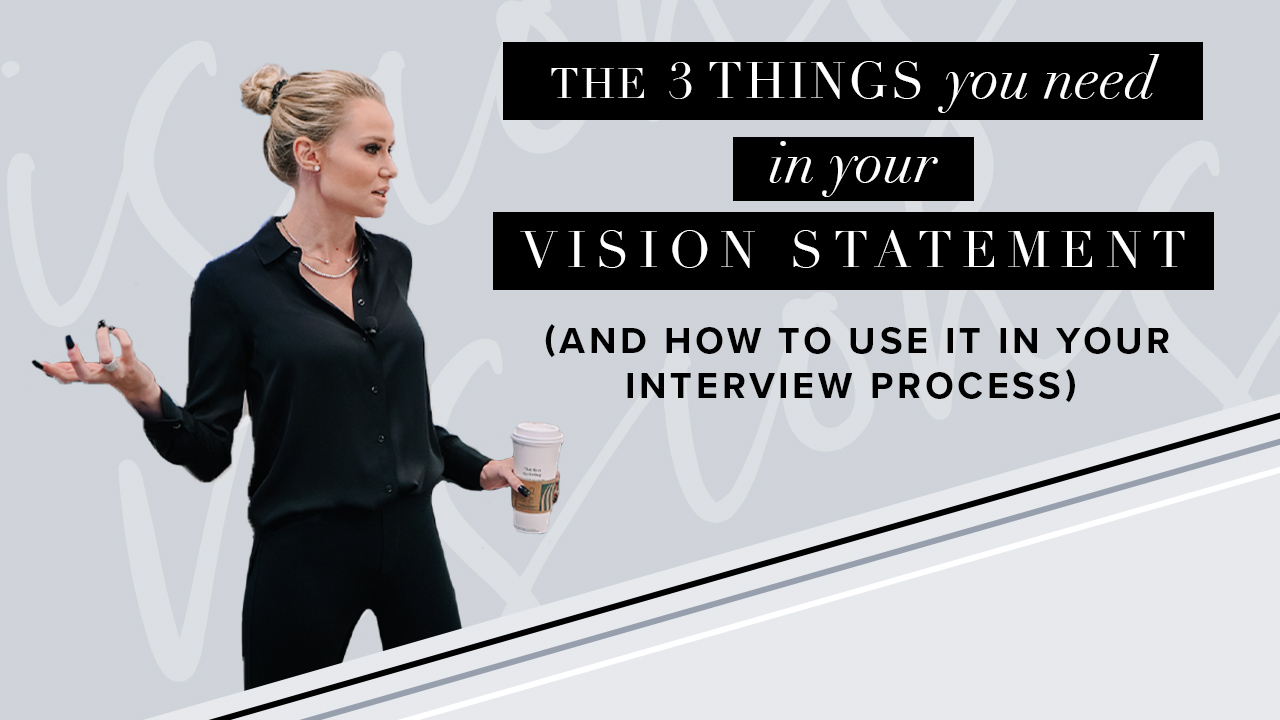If you know anything about the way I support entrepreneurs in their efforts to 10X their businesses, then you already understand how powerful it is to use clear mission, vision, and value statements. They unquestionably help organizations accomplish their goals by providing a framework for their overarching strategy, identifying the most important areas of focus, and how to make the right decisions at the right time. I’ve seen it time and time again.
What I’ve also seen time and time again is the confusion that arises when the conversation comes to mission, vision, and value statements. They’ll often get used interchangeably, but I’m here to remind you that they’re distinctly different statements driven by entirely different purposes. And they all matter, so it’s important to know the difference.
In essence:
Your mission statement conveys the “why”. It’s why your business exists.
Your vision statement represents where the business is going in the next ten years.
Your values statement communicates who you hire, reward, and fire.
All different. All vital. But often overlooked by businesses who might have a great core idea but just can’t get it together well enough to scale and grow. Dialing in these statements across your entire organization so that you all know them and feel them and act in accordance with them creates the roadmap that makes 10X-ing your business possible.
So let’s assume that your business has a mission statement, and let’s focus on the vision. Too many business owners and teams get caught up in day-to-day tasks — the hamster wheel of “just good enough” — that they don’t ever move their business forward. It’s professional inertia.
How do you avoid stagnancy? By developing, communicating, and acting on a vision.
The crucial considerations for making an effective vision
Remember, your vision’s purpose is to describe what you want to achieve in the long-run for your organization.
- The vision is designed to describe the long term target for the organization.
- Without a target, what is guiding day to day activities and strategic planning? If you don’t know today that you want to impact 1000 people, how will you organize the businesses resources? Let me tell you: chaotically. Devoid of a clear vision, you will chase “good” ideas and lose focus on the main thing. As a leader, it is your job to set the direction and continuously point back to it.
- The long-term change resulting from your work should be clear and inspirational.
- Again, clarity is crucial. As is conveying something your team can rally around, aspire to, and be inspired by. If where you’re going doesn’t excite you, you need to think bigger so that you put the energy behind what it’s going to take to achieve your goals. Start thinking 10X today so you’ll take 10X action.
- Your vision is a tool you must use to lead your group or organization to achieve quality results.
- Yes, this is aspirational, but it’s also operational. What will you achieve in the next 10 years? Why does this matter? Because your vision of your business is not a time for, “Yeah, but what about….?”-type thinking. You’re distracting yourself from creating the best-possible version of your business. This is your legacy. This is your moonshot. Let’s get the team organized and start executing!
Now that you’re in the right mindset for creating a clear, actionable vision, I’m going to push you even further — you need three distinct vision statements. One vision statement for your brand, one for your people, and one for your revenue.
Why have three versions? You are looking for an array of team members to join you in taking the hill and you need to account for the fact that people aren’t all motivated by the same things. Some will be compelled by the brand, others the people, and a small group the financial impact. These are crucial elements of your organization, and this creates even more clarity about where your business is going in the next ten years.
Growth comes with challenges and you are looking for people who get excited about solving the same problems you do. Saying “ABC company wants to be the best” is a nice vision for someone who takes things at face value. But to get to where you want to go, you need to start assimilating a rockstar group of team members who are specifically driven to achive a result – so let’s break them down:
Brand: Legacy and Impact Vision Statement
What is the quantifiable impact you are looking to make in the lives of your clients, patients, or customers? THIS is your brand vision statement. Your brand ultimately defines legacy and communicates its impact. Don’t treat it as though it’s out of your control. Use your Brand Vision Statement to intentionally direct the overall impact the business will create and the legacy you want to build over the next 10 years.
CARDONE VENTURES EXAMPLE: IMPACT 1 MILLION 10X BUSINESSES
People: Culture and Team Vision Statement
It’s simply a fact: Businesses don’t move people — it’s people that move businesses. In order to move the business in the direction you want it to, you need a clear, team-centric vision to guide them. The People Vision Statement should share the goal for the type of culture and team alignment you’re targeting.
CARDONE VENTURES EXAMPLE: CREATE 50,000 10X EMPLOYEES
Revenue: Financial Vision Statement
Businesses are created to solve problems and generate wealth. Therefore, there shouldn’t be anything mysterious about your financial vision. Do you know your 10-year financial goal? If not, set the intention, and take the action. If your team is “not interested” in money, we need to take a step back. Just remember: you are interdependent on the people you’ve chosen to help you hit your goals. If they aren’t serious about changing their own financial condition, why do you expect them to help you with yours?
CARDONE VENTURES EXAMPLE: $10 BILLION IN REVENUE
Vision statements can be hard to develop, because you likely started your business because you wanted to move AWAY from something – a bad boss, dead end job, etc. But how you got into business ownership is irrelevant because now your focus needs to shift to what you’re CREATING. To truly create an impact, your goals and team will require long-term, strategic thinking and a clear decision: where are you going?
Your vision goes hand-in-hand with your mission and your values to create a core element of your business’s foundation. Click here for a reminder of how to craft your mission statement.
Want to focus even more on your vision statement? Use this worksheet to see examples of some of my favorite vision statements and map out your own.
There are many more ways in which you can use your vision to attract the team and clients you deserve to scale your business and achieve your goals. Join us for one of our People Essentials events to understand precisely how Cardone Ventures can help.
Learn more at cardoneventures.com/people.

